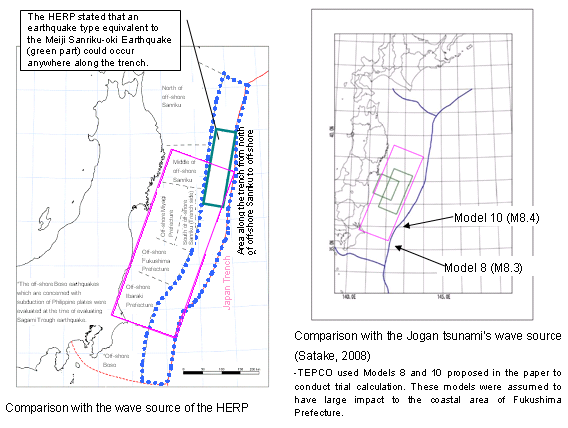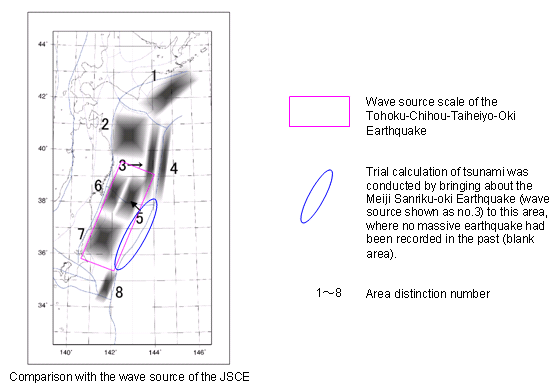The Tokyo Electric Power Company, Incorporated, would like to make comments on subjects that are reported by the newspapers, TV or websites.
April 24, 2012
1.Overview
The scale of the earthquake that caused the tsunami was M9.0, the largest ever recorded in Japan, and the fourth largest ever recorded in the world. The earthquake was caused by an interlocking movement of several regions off-shore of Iwate to Ibaraki prefectures with a length north to south of approximately 500 km, a width from east to west of approximately 200 km, and a maximum slip of more than 50 m. The potential occurrence of an earthquake of this scale was outside the radar of not only TEPCO but also the Central Disaster Prevention Council of the Cabinet Office and the Headquarters for Earthquake Research Promotion (HERP) established in the Ministry of Education, Culture, Sports, Science and Technology.
2. Past Tsunami Evaluations
(Review during Construction)
At the point of construction of Fukushima Daiichi Nuclear Power Station, in adhering to TEPCO's basic policy of always keeping safety first, the plant was designed to be able to withstand even a tsunami equivalent to the maximum tide level ever recorded on the shores of Fukushima. Specifically, this would be the tsunami that followed the Chilean earthquake which was approximately 3 m high at Onahama Port. This standard was written into the application for the establishment permits that were submitted to the government and subsequently approved.
(Updating the Evaluation with the Guideline Published by Japan Society of Civil Engineers (JSCE))
Later, in 2002, the JSCE published a guideline called the "Tsunami Assessment Method for Nuclear Power Plants in Japan" ![]() based on the ongoing technological progress. In this assessment, simulation technology was applied and the results were assumed to be more conservative. Based on this guideline, TEPCO reevaluated the tsunami height, which was assessed to be approx. 6 m. In response to the results, TEPCO has voluntarily implemented measures while reporting them to the government. This tsunami evaluation technology has been the standard method for domestic nuclear power plants up to the time of the accident and is also used for assessing tsunamis at nuclear power plants all around Japan to report to the government including the ones located along the Pacific coastline.
based on the ongoing technological progress. In this assessment, simulation technology was applied and the results were assumed to be more conservative. Based on this guideline, TEPCO reevaluated the tsunami height, which was assessed to be approx. 6 m. In response to the results, TEPCO has voluntarily implemented measures while reporting them to the government. This tsunami evaluation technology has been the standard method for domestic nuclear power plants up to the time of the accident and is also used for assessing tsunamis at nuclear power plants all around Japan to report to the government including the ones located along the Pacific coastline.
Although TEPCO believed that the nuclear power plant safeguards put in place were sufficient per this standard, we deeply regret the accident that occurred on March 11th.
3. Incorporating the Latest Knowledge and Theories
Although TEPCO believed that nuclear power plant safeguards had been secured per the standard set down by the Society of Civil Engineers, much consideration was given to applying the latest knowledge and research to the power plant design and operations. In addition, close attention was paid to the latest research trends dealing with earthquakes and tsunamis for the purpose of conducting in-house investigations.
For example, in July 2002, the HERP published a statement that "there is a possibility that an M8 earthquake could occur anywhere along the trench off the coast from Sanriku to Bousou"![]() . The JSCE decided to respond to this statement by conducting a probabilistic analysis method given that there was a large area along the trench off the coast of Fukushima where no massive earthquake had ever occurred in the past. The study and development of this method is planned to take place from 2003. In 2006, TEPCO conducted a hypothetical analysis utilizing this JSCE Probabilistic Tsunami Hazard Analysis methodology and it showed that the occurrence of a tsunami exceeding 10 m could only occur once every 100 thousand to a million years. However, this analysis was conducted for the purpose of con firming adaptability and improving methods that at the time were still in development. Thus, TEPCO did not interpret this figure to literally mean the actual frequency of tsunamis that could strike the nuclear power plant in Fukushima.
. The JSCE decided to respond to this statement by conducting a probabilistic analysis method given that there was a large area along the trench off the coast of Fukushima where no massive earthquake had ever occurred in the past. The study and development of this method is planned to take place from 2003. In 2006, TEPCO conducted a hypothetical analysis utilizing this JSCE Probabilistic Tsunami Hazard Analysis methodology and it showed that the occurrence of a tsunami exceeding 10 m could only occur once every 100 thousand to a million years. However, this analysis was conducted for the purpose of con firming adaptability and improving methods that at the time were still in development. Thus, TEPCO did not interpret this figure to literally mean the actual frequency of tsunamis that could strike the nuclear power plant in Fukushima.
Additionally, while reviewing the seismic safety evaluation, in 2008, TEPCO conducted another trial calculation utilizing the wave source model of the Meiji Sanriku-oki Earthquake along the trench off-shore Fukushima (the result: 15.7 m). However, the validity of this wave source model had been in question. TEPCO has requested that JSCE review the suitability of this hypothesis, including whether or not it would be feasible to assume the existence of a wave source in areas where no earthquake had previously occurred. The statement of the HERP assuming that an earthquake might occur anywhere along the trench off-shore Fukushima was not covered in the Central Disaster Prevention Council tsunami evaluation or in the tsunami evaluation for disa ster prevention done at each municipality.
Moreover, TEPCO has reviewed the paper that mentioned the Jogan tsunami occurrence in 869 (Satake, 2008 ![]() ), issued in April, 2009. However, the wave source models in the paper were based on the results of the tsunami deposit survey in the Sendai Plain and Ishinomaki Plain. Therefore, the location and scale of the tsunami remained unverified. The tsunami deposit survey in the coastal area of Fukushima Prefecture and other adjustment areas were required for their establishment. TEPCO conducted tsunami deposit surveys, and as a result, an altitude of about 4m in the northern part of Fukushima Prefecture was confirmed for the tsunami deposits carried by the Jogan tsunami while no tsunami deposits were found in the southern part. As there were inconsi stencies between the results of the investigation and the trial calculation via using the proposed wave source model (the result: 9.2 m), TEPCO considered it necessary to conduct further investigation and research in order to determine the wave source of the Jogan tsunami.
), issued in April, 2009. However, the wave source models in the paper were based on the results of the tsunami deposit survey in the Sendai Plain and Ishinomaki Plain. Therefore, the location and scale of the tsunami remained unverified. The tsunami deposit survey in the coastal area of Fukushima Prefecture and other adjustment areas were required for their establishment. TEPCO conducted tsunami deposit surveys, and as a result, an altitude of about 4m in the northern part of Fukushima Prefecture was confirmed for the tsunami deposits carried by the Jogan tsunami while no tsunami deposits were found in the southern part. As there were inconsi stencies between the results of the investigation and the trial calculation via using the proposed wave source model (the result: 9.2 m), TEPCO considered it necessary to conduct further investigation and research in order to determine the wave source of the Jogan tsunami.
(The Earthquake in March, 2011)
As shown in the figures below, the focal area of the earthquake in March, 2011, expanded widely from the region off-shore of Iwate to Ibaraki prefectures, an area stretching 500 km by 200 km. The scale completely differs from either the assumed earthquake along the trench off-shore Fukushima proposed by the HERP, or the Jogan earthquake. The scale was so massive that it could be described as an action caused by several simultaneous wave sources, which were required to be assessed individually in the JSCE "Tsunami Assessment Method for Nuclear Power Plants in Japan". Consequently, based on the accumulated knowledge at the time, the Tohoku-Chihou-Taiheiyo-Oki Earthquake could not have been foreseen and TEPCO also considers the height (scale) of the tsunami that followed this earthquake to have been unpredictable.
In spite of the conclusion reached that the occurrence of a tsunami the size of the one that occurred on March 11th were beyond the predictive powers of TEPCO and any other Japanese organization engaged in seismic activity research, we deeply regret and apologize that the safeguards and measures put in place consequently turned out to be insufficient. From here on out, we will do our very best to apply the lessons learned from the tragic events that unfolded on that fateful day and make every effort to ensure the utmost in preparedness should another large-scale natural disaster occur.
 |
 |
© Tokyo Electric Power Company Holdings, Inc.